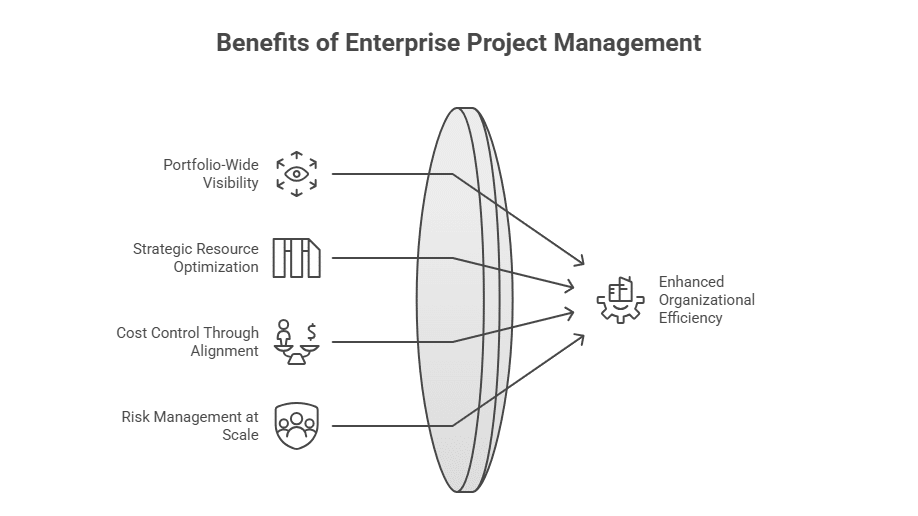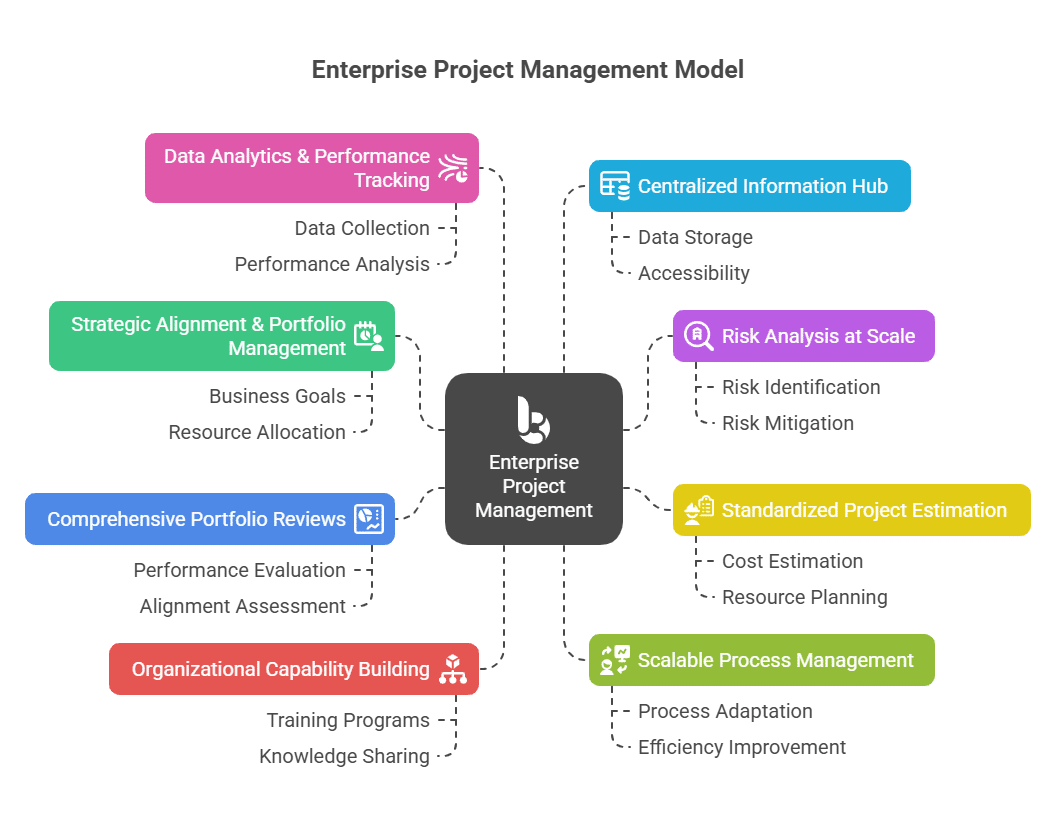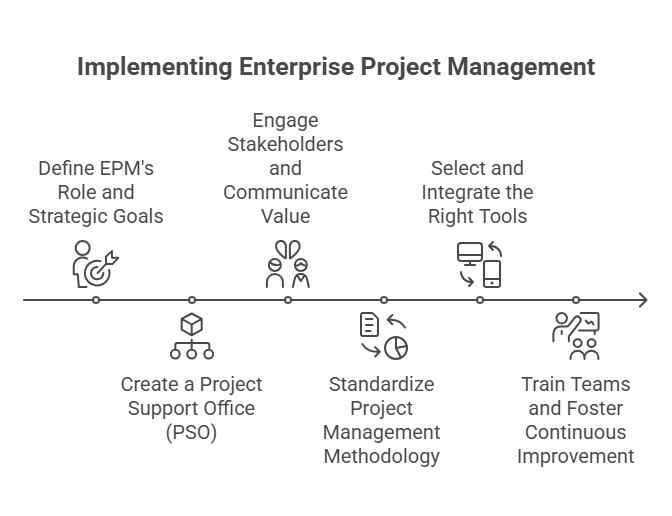Your most successful projects might be sabotaging your company’s future. Sounds impossible? Every day, organizations watch individual projects hit their targets while strategic goals slip further away. Marketing launches their campaign flawlessly. IT delivers the new system on time. Operations cuts costs by 15%. Yet somehow, the company isn’t moving forward, it’s just getting busier.
“Sabotage” might be too strong a word, but that disconnect isn’t a coincidence. It’s what happens when projects operate in isolation, each pursuing tactical wins without a strategic compass. In this article, we’ll explore how Enterprise Project Management transforms scattered successes into coordinated progress.
On this page:
- What is Enterprise Project Management?
- What Does an Enterprise Project Manager Actually Do?
- How is EPM Different from Traditional Project Management?
- 4 Benefits of Enterprise Project Management
- The Enterprise Project Management Model
- Implementing Enterprise Project Management
- Final Thought

Ultimate Guide to PMP® Certification
Navigate the process of becoming a PMP® certified professional.
What is Enterprise Project Management (EPM)?
“We need to work smarter, not harder.”
Great advice, until you realize your “smart” projects are working against each other. Three departments, three brilliant strategies, zero coordination. Each team optimizes for their own metrics while the company’s bigger goals get lost in the shuffle. Smart work becomes wasted work when it’s not connected work.
Enterprise Project Management (EPM) disrupts this pattern by creating a centralized coordination system for your entire project portfolio. Instead of managing projects in isolation, EPM aligns every initiative, from infrastructure upgrades to marketing campaigns, with the same strategic objectives. It’s the difference between having brilliant individual performers and having an orchestra. Same talent, exponentially better results through coordination, efficiency, and unified direction.
But who’s actually conducting this orchestra? The Enterprise Project Manager.
What Does an Enterprise Project Manager Actually Do?
If a traditional project manager is like a contractor building your kitchen renovation, focused on getting that specific job done on time and on budget, an Enterprise Project Manager is more like the general contractor overseeing your entire home remodel, making sure the kitchen timeline doesn’t conflict with the bathroom work and that all the upgrades actually work together to increase your home’s value.
An Enterprise Project Manager operates from within the Enterprise Project Management Office (EPMO), where they coordinate multiple projects happening simultaneously across different departments. Unlike regular project managers who focus on delivering one project successfully, Enterprise PMs ensure that all projects align with the organization’s strategic roadmap and support each other rather than compete for resources.
Most Enterprise PMs have 5+ years of project management experience, often with PMP certification, and earn around 128K+ annually.
How is EPM Different from Traditional Project Management?
The fundamental difference lies in scope and strategic focus. Traditional project management is like zooming in with a microscope—intense focus on delivering one specific project successfully. Enterprise Project Management is like switching to satellite view—managing an entire ecosystem of interconnected projects.
Traditional PM asks: “How do we deliver this project on time and on budget?” EPM asks: “How do we ensure all our projects collectively drive the organization forward?” It’s the difference between optimizing individual performance versus optimizing system performance.
While a traditional project manager coordinates one team toward one goal, an Enterprise Project Manager orchestrates multiple teams across departments, managing dependencies, resource conflicts, and strategic alignment simultaneously. Traditional PM measures success by delivery metrics—did we hit our timeline and budget? EPM measures success by business impact—did our projects actually move the strategic needle? The complexity multiplies exponentially. Instead of managing one timeline, EPM manages interconnected timelines. Instead of one budget, multiple budgets that compete for shared resources. Instead of one set of stakeholders, stakeholders across the entire organization with competing priorities.
Traditional Project Management vs Enterprise Project Management
| Aspect | Traditional Project Management | Enterprise Project Management |
|---|---|---|
| Scope | Single project with defined boundaries | Multiple interconnected projects across organization |
| Primary Focus | Project delivery (time, budget, scope) | Strategic alignment and business value realization |
| Team Structure | Single dedicated project team | Multiple teams across departments and functions |
| Success Metrics |
• On-time delivery • Within budget • Scope completion |
• Strategic objective achievement • Portfolio ROI • Cross-project synergies • Organizational capability building |
| Complexity Level |
Moderate
Single project variables
|
Very High
Multiple interdependent variables
|
| Risk Management | Project-specific risks and mitigation | Portfolio-level risks, dependencies, and strategic risks |
| Resource Management | Dedicated project resources | Shared resources across multiple competing priorities |
| Stakeholder Scope | Project sponsors and direct stakeholders | C-level executives, multiple departments, external partners |
| Timeline Horizon | Project lifecycle (weeks to months) | Strategic planning cycles (quarters to years) |
| Decision Making | Project-level decisions within defined authority | Strategic prioritization and resource allocation decisions |
| Budget Range |
$10K – $1M+ per project
Single budget management
|
$1M – $100M+ portfolio value
Multiple budget coordination
|
| Required Experience |
2–5 years project management
Project-specific expertise
|
5+ years with strategic experience
Cross-functional leadership
|
| Average Salary Range |
$65K – $85K
Based on project complexity
|
$95K – $130K
Based on portfolio value and strategic impact
|
| Tools & Systems |
• Project-specific tools • Gantt charts • Basic reporting |
• Enterprise PPM software • Portfolio dashboards • Advanced analytics • Integration platforms |
4 Benefits of Enterprise Project Management
The shift from managing individual projects to orchestrating entire project portfolios delivers significant advantages that compound across the organization. Here’s what enterprises gain when they make the jump to EPM:

#1. Portfolio-Wide Visibility
Instead of managing projects in silos, EPM creates a bird’s-eye view of everything happening across the organization. This visibility transforms resource management, when Team A is short-staffed and Team B is wrapping up a project, the EPM team can quickly reassign resources where they’re needed most.
But it goes deeper than staffing. EPM reveals redundant projects that compete for the same resources or duplicate efforts. Rather than having three departments unknowingly work on similar customer data initiatives, EPM spots these overlaps early, allowing you to combine efforts or eliminate duplicates. The result? Employees get freed up to work on projects that actually align with strategic objectives, and scheduling becomes simpler with less overtime needed.
#2. Strategic Resource Optimization
When you can see what everyone is doing across the entire organization, resource management becomes strategic rather than reactive. EPM enables cross-project coordination that traditional project management simply can’t achieve—like combining two meetings covering similar topics, giving employees more focused work time and boosting overall productivity.
#3. Cost Control Through Alignment
Increased efficiency directly translates to cost savings, but EPM’s real financial impact comes from strategic alignment. Organizations stop funding projects that don’t serve company goals and avoid hiring unnecessary personnel. Project visibility ensures spending happens where it creates the most value, turning project budgets into strategic investments rather than departmental expenses.
#4. Risk Management at Scale
Perhaps most importantly, EPM enables portfolio-level risk analysis and mitigation. Instead of managing risks in isolation, you can see how challenges in one project might impact others and address systemic issues before they cascade. This interconnected approach to risk monitoring consistently delivers better project outcomes across the entire portfolio.
The Enterprise Project Management Model
Enterprise Project Management operates as a comprehensive framework that manages projects strategically across the entire organization, ensuring alignment with business goals while optimizing resource allocation. Unlike traditional project management that focuses on individual deliverables, the EPM model emphasizes centralized oversight, standardized processes, and data-driven decision making to maximize organizational efficiency.

Strategic Alignment & Portfolio Management
The foundation of EPM lies in ensuring every project contributes to overall strategic objectives. This means continuously evaluating how individual projects fit within the broader organizational roadmap and making adjustments when strategic goals shift. EPM provides the centralized platform needed to monitor not just project progress, but how that progress advances company-wide priorities.
Risk Analysis at Scale
Risk management in EPM operates at both individual project and portfolio levels. While traditional project management deals with isolated risks, EPM must identify and mitigate interconnected risks across multiple projects simultaneously. This complexity requires sophisticated risk analysis that considers how challenges in one project might cascade through the entire portfolio, enabling proactive rather than reactive risk management.
Standardized Project Estimation
EPM establishes consistent methodologies for project estimation across the organization. Rather than each project manager using their own approach, the EPM framework provides standardized guidelines for estimating costs, durations, and resource requirements. This standardization enables more accurate portfolio-level planning and ensures all projects are evaluated using the same criteria.
Comprehensive Portfolio Reviews
The EPM team maintains centralized oversight through systematic project reviews that monitor four key phases: Project Commitment, Startup, Progress, and Close-out. This real-time visibility enables immediate response when risks emerge and allows for quick portfolio adjustments when strategic priorities change. The goal is proactive management rather than reactive problem-solving.
Organizational Capability Building
EPM goes beyond project delivery to build organizational capabilities through project management coaching. The EPM team mentors project managers across departments, creating a cohesive company culture with standardized PM language and practices. This investment in capability building ensures improved communication and collaboration throughout the organization.
Scalable Process Management
Enterprise project management implements standardized escalation and issue management processes that scale across the organization. Critical issues get prioritized appropriately, while the EPM team maintains clear processes that all project managers follow. This systematic approach ensures efficient resource allocation and prevents bottlenecks from derailing multiple projects.
Data Analytics & Performance Tracking
Advanced time tracking and centralized information systems provide the data analytics foundation for continuous improvement. Tools like Replicon for time tracking and Asana for project reporting give the EPM team insights into project performance, resource utilization, and potential bottlenecks. This data-driven approach enables informed decision-making and identifies opportunities for process optimization.
Centralized Information Hub
The EPM model relies on centralized management systems that provide real-time visibility into resources and project status across the organization. These platforms serve as the single source of truth for executive reporting and enable stakeholders to make informed decisions throughout the project lifecycle.
Implementing Enterprise Project Management
Enterprise Project Management (EPM) is more than a new title or toolset. It is a strategic system that standardizes how your organization manages projects at scale. Implementing it successfully requires clear structure, strong leadership, and the right tools and processes. Here’s how to get started:

Step 1: Define the Role and Build Your Team
Start by defining how the EPM function fits into your organization. What will the enterprise project manager (EPM) oversee, and how will they support existing project managers? Then, appoint your EPM leader—either promote internally or hire someone with cross-functional experience. Create a job description that reflects EPM’s strategic and collaborative nature.
Step 2: Create a Project Support Office (PSO)
Establish a supporting office that helps manage project data, track performance, assess risks, and assist with portfolio governance. This office is more than admin support—it ensures EPM standards are adopted and used consistently across the organization.
Step 3: Engage Stakeholders and Communicate Value
EPM success depends on buy-in from executives, department heads, and project teams. Use clear reporting tools and dashboards (like Smartsheet or Monday.com) to keep stakeholders informed on project progress, KPIs, and alignment with business goals.
Step 4: Standardize Project Management Methodology
Choose one core methodology—Agile, Waterfall, Hybrid, or a blend—and require all project teams to follow it. Standard workflows reduce confusion, improve collaboration, and provide consistent data across projects.
Step 5: Select and Integrate the Right Tools
Adopt tools that support portfolio-level oversight, time tracking, scheduling, budgeting, and collaboration. Consider what project managers already use and choose platforms that integrate easily with your existing systems.
Step 6: Train Teams and Foster Continuous Improvement
Equip teams with training on the chosen tools and methodology. Encourage ongoing evaluation, process refinement, and regular reviews to ensure the EPM approach continues to support strategic objectives.
Final Thought
There are many good reasons to use an enterprise project management system. They include better visibility, cost reduction, and more efficiency. Once you’ve decided to implement an EPM system, follow the steps in this article to ensure you have the right team and tools in place. Project Management Academy can provide more information on using your Project Management Professional (PMP)® certification for enterprise project management.


 New Horizons
New Horizons
 Project Management Academy
Project Management Academy
 Six Sigma Online
Six Sigma Online
 TCM Security
TCM Security
 TRACOM
TRACOM
 Velopi
Velopi
 Watermark Learning
Watermark Learning
 Login
Login




 New Horizons
New Horizons
 Project Management Academy
Project Management Academy
 Velopi
Velopi
 Six Sigma Online
Six Sigma Online
 TCM Security
TCM Security
 TRACOM
TRACOM
 Watermark Learning
Watermark Learning